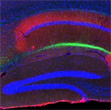Wednesday, 5 November 2014
A Brain Circuit That Links Two Events in Time

If you’re out in a storm and you see a bolt of lightning streak across the sky, you tend to pull your head down between your shoulders for the next few seconds, fearing the big thunderclap that you expect to come next. This kind of association between a stimulus and a potential danger is something that the human brain retains easily, because it has always had an obvious importance for our survival.
A study co-ordinated by MIT professor Susumu Tonegawa and published in the journal Science in January 2014 reveals the neuronal bases of this association between a stimulus and the timing of a potential danger, about which relatively little was previously known compared with the association with the other essential property of a danger: its location. In the latter case, the hippocampus, the key brain structure for encoding memories, makes use of place cells, which are activated when you are in or are remembering a specific location.
But when it came to temporal associations, prior to Tonegawa’s study, little was known except that, as the same researcher had shown in an earlier study, the interval separating the two events could be as long as 20 seconds. In the same study, Tonegawa also identified a neuronal circuit that is necessary for the establishment of such associations. Known as the monosynaptic circuit, it connects layer 3 of the entorhinal cortex to the CA1 region of the hippocampus. This entorhinal cortex is in a sense the gateway to the hippocampus which receives information from the sensory areas of the cortex.
What the new study revealed was the presence of another, previously unknown circuit that can inhibit the monosynaptic circuit and thus prevent a temporal association between two stimuli from forming. This inhibitory circuit originates in neurons of layer 2 of the entorhinal cortex (shown in green in the image above) which excites inhibitory neurons of the CA1 region of the hippocampus (shown in blue). These neurons can then inhibit the activity of the CA1 neurons contributing to the monosynaptic circuit that facilitates the temporal associations.
The presence of this “brake” that can limit the time window during which an association can form very likely plays an important functional role as well. It would not be very adaptive for us to form cause-and-effect associations between phenomena that were distant in time and had nothing to do with each other. This inhibitory circuit therefore probably helps to set a time limit beyond which it is no longer useful to remember a possible causal link between two events.
The experiments that made these findings possible employed a technology called optogenetics, which can be used to modify the activity of entire populations of genetically targeted neurons. In these experiments, the researchers successfully lengthened beyond 20 seconds the maximum interval during which two stimuli can be associated by increasing the activity of the neurons in layer 3 of the entorhinal cortex or by suppressing the activity of the neurons in layer 2. And conversely, stimulating these neurons in layer 2 or inhibiting those in the monosynaptic circuit in layer 3 shortened the period during which such an association could be formed. It all seems very simple and easy when it’s described like that, but it’s the kind of demonstration that electrophysiologists didn’t even dream possible scarcely 10 years ago, before the advent of optogenetics.
![]() In the brain, timing is everything
In the brain, timing is everything
![]() Island Cells Control Temporal Association Memory
Island Cells Control Temporal Association Memory
![]() Investigating Neural Representations: The Tale of Place
Investigating Neural Representations: The Tale of Place
Memory and the Brain | Comments Closed







